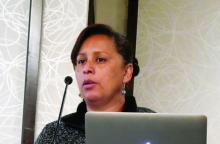Questionnaires completed by participating students at the start of the program highlighted how ubiquitous suicide remains in the Apache community. A quarter of the students said they had a family member who had attempted suicide, more than a third knew a friend who had attempted suicide, and 15% reported losing a friend, sibling, or parent to suicide. In addition, roughly half of the students said that they knew an adult who was important in their life with a substance abuse problem, that they had no strong sense of belonging to an ethnic culture, and that they had not spent time learning about their culture, Dr. O’Keefe said.
Initial data from questionnaires completed at the end of the elders program showed high levels of enjoyment among the students and high levels of retention of some information. For example, after the elders’ program, 96% could identify their clan, and 96% could say what is sacred about the Apache land, she noted. Further data analysis is in progress, Dr. O’Keefe said, and she and her associates are adapting the elders program for use by other Native communities.
A third report from a researcher on the Johns Hopkins staff reviewed work they have been doing to “develop a culturally informed typology of social risk and protective factors” that might influence youth suicide behavior in the White Mountain Apache Tribe. An initial iteration of this typology appeared in 2014 Qual Health Res. 2014 Nov;24[11]:518-26), but the researchers wanted to include additional social and cultural influences and so recently organized 32 youths, tribe professionals, and elders into discussion groups to identify new factors affecting suicide risk. New themes they identified for the typology included contagion, violence, substance use, spirituality, negative expectations, bullying, trauma, social support, Apache strength, and others. The researchers are in the process of using these new factors to revise their model of suicide risk pathways among members of the Apache tribe, said Mary F. Cwik, PhD, a senior investigator for the Johns Hopkins and Apache suicide program.Dr. Haroz, Dr. O’Keefe, Ms. Goklish, and Dr. Cwik had no disclosures.



